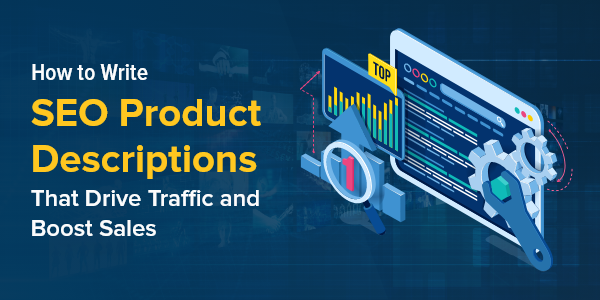How to Write SEO Product Descriptions That Drive Traffic and Boost Sales

Tiffany Reyes
Project Manager, B2B Team Lead

When it comes to any site, it’s vital to have all pages, but especially your most important pages, properly optimized. In the world of e-commerce, it’s likely that your most important pages are going to be your product pages. Having SEO product descriptions that clearly convey the information that will persuade and drive customers to make a buying decision is crucial. This blog will dive into what properly optimized descriptions are, why they are so vital, and how to write them so they bring traffic, engagement, and sales to your most important pages.
Understanding the Importance of SEO Product Descriptions
What are SEO Product Descriptions?
A properly optimized SEO product description is going to have two elements: keyword-rich content and clarity. The main goal of having keyword-rich content is to increase the likelihood of the landing page being seen in search engine results pages (SERPs), and the main goal of having clarity is to equip your customers with all the information they want and need to make a purchase.
Benefits of Optimizing Product Descriptions for SEO
A. Increased Visibility in Search Engine Rankings
People won’t be able to find your products if they’re buried on the 32nd page of Google. This is why optimizing your product descriptions with the proper keywords is a must, especially if you want to increase your website’s visibility in the SERPs. The more content you create targeting your most important keywords, the more you increase your chances of ranking on the first page.
B. Improved User Experience and Engagement
When a customer comes to any page on your site, you want to keep them engaged. With a well-crafted product page, a customer is met with useful information about the product they might already be interested in. But even more than that, they are sure to find more helpful information through things like instructional videos, reviews, FAQs, blogs, or complimentary products to the ones they are already looking into. All of this helps to enhance the user experience for your site visitors and encourages them to learn more about other products and possibly purchase more than they originally planned.
C. Higher Conversion Rates and Sales
Proper research is vital to knowing what your ideal customer is searching for. Part of crafting an SEO-optimized product description is planting keywords that line up with the intent of online users into your descriptions. Doing this will enhance the chances of attracting the right customer to your pages and in turn, increase the likelihood of a sale.
Key Elements of SEO-Friendly Product Descriptions
SEO-friendly product descriptions should have a few key elements in order for them to attract the right visibility and conversions. Here are some things you should keep in mind:
1. Writing for Buyers, Not Bots
Bots aren’t the ones purchasing your products, real people are. With this in mind, don’t let “ranking on Google” completely derail the train when writing your SEO product descriptions. Write content that is customer-centric. (What would they want to know? What do they need to know?) Answer those questions with your product descriptions in a way that is conversational while presenting a solution to your customer’s needs.
2. Highlighting Benefits and Including Features
When writing your product descriptions, aim to find a sweet spot between highlighting the important features the product has to offer, while also presenting the benefits and ways it could enhance your customers’ life in some fashion.
3. Targeting the Right SEO Product Keywords
Make sure you have a beat on what your customers are searching for online. This is where proper keyword research comes into play. You can use tools like Google Trends, Ahrefs, SEMRush, or similar tools to help you do this to identify your audience’s search intent.
4. Strategically Placing Keywords for Maximum Impact
Once you’ve done your keyword research, the last thing you want to do is overstuff your content with these keywords as this could potentially hurt your rankings. You don’t want your web pages to be like an overstuffed Chipotle burrito! It’s best to place your keywords strategically throughout your web pages, think of places like headers, titles, and within the actual descriptions.
5. Tailoring Length Based on Buyer Awareness
It’s important to take into account how much awareness your customers are coming to your site with. If your customer needs some more education about your product due to a unique feature or benefit, it would be wise to tailor the length of your content as such. Depending on where the customer is in the buyer journey, this can change.
6. Creating a Clear Call to Action (CTA)
Make sure you place clear call-to-action cues within your SEO product descriptions. Your page should always lead the customer toward an action. Most times, this will be to make a purchase, but this can also be other actions like setting up a call or even subscribing to your email newsletter.
7. Crafting Unique Product Descriptions for Each Product
Opt for writing original content when crafting your product descriptions. Try to avoid using duplicate content from another site as this will typically get flagged by Google. Original content is always the better option.
Avoiding Common Mistakes in SEO Product Descriptions
Now that we’ve gone through the key elements you should aim to incorporate in your product descriptions, let’s look at a couple of things you should steer clear of:
1. Overusing Keywords and Stuffing
Keywords are great, but as we mentioned before, overusing keywords can hurt your SEO and lessen the likelihood that your content sounds like it’s been written for real people like you and me. Be strategic with your keyword placement.
2. Using Duplicate Content from the Manufacturer
It may be tempting to just scrap the content provided by the manufacturer, but avoid this at all costs, as it can dock your rankings. Always opt for using that as a resource but writing original content.
3. Ignoring Mobile Optimization and Responsiveness
Nowadays, many people are making purchases right from their mobile devices. Keeping this in mind, make sure your product pages (descriptions included) are mobile-friendly.
4. Neglecting to Highlight Unique Features and Benefits
When presenting your product to a potential customer online, it’s important to emphasize each unique quality that differentiates it from your competitors. Be sure to showcase this within your descriptions clearly and concisely. Your customer should know why they should choose you over the alternative option.
5. Missing Opportunities for Internal Linking and Cross-Promotion
Internal linking can enhance your product pages immensely. Opportunities, where you can utilize interlinking, are by linking to related products or other helpful resources on your website, such as a blog article or relevant resources page. This gives your customer a chance to learn more about what you have to offer.
Optimizing Product Descriptions for User Experience
In addition to the content of your product descriptions, there are other ways you can further enhance the user experience of your product pages.
1. Incorporating High-Quality Product Images and Videos
Make sure your product pages are just as visually engaging as the content is. Some ways you can achieve this is with high-resolution images and videos that highlight the most important benefits your product has to offer. As the old saying goes, a picture is worth a thousand words.
2. Providing Detailed and Accurate Product Information
Opt to provide your customers with as much detail as possible. Product information that is thorough and accurate helps to position you as an authority on the subject and helps to build trust with your customers.
3. Showcasing Positive Customer Reviews and Testimonials
Another way to build trust with your customers is to highlight real customer reviews and testimonials. It helps to provide social proof when others are raving about the product just as much as you are.
4. Utilizing Structured Data and Rich Snippets for Enhanced Visibility
Take time to utilize structured data and rich snippets on your product pages so that search engines can better understand what your web pages are about. Doing this will increase the likelihood of them being displayed on the SERPs and being found by potential customers.
Commonly Asked Questions About SEO Product Descriptions
1. How Do I Add SEO Elements to My Product Descriptions?
Conducting detailed keyword research is vital. Your findings will aid you in being strategic with your keyword placement, writing original content that is helpful and informative, and optimizing your product pages for the best user experience and visibility. Some additional elements to address are onsite SEO (headers, titles, and meta descriptions), image alt text, and a clean URL.
2. What Is the Ideal Length for SEO Product Descriptions?
The ideal length is dependent on the product and the information that is needed to properly educate the customer about the product. You should aim to provide as much detail as necessary to give the customer a comprehensive understanding of the product features and benefits.
3. What Should I Include in My Product Descriptions?
The essential elements to include in your SEO product descriptions are an intro about the product, benefits, any unique or special features, and clear calls to action throughout.
Writing optimized product descriptions doesn’t have to be intimidating, but when done right, it can impact your online business in a significant way. Once you understand the importance of SEO product descriptions, how to incorporate the key elements for optimization, and enhance them for the best user experience, you’ll be well on your way! Do the legwork upfront to research your most important keywords and your customer’s search intent, steer clear of common mistakes, and always look for ways to improve and fine-tune your product pages to create the most helpful and enjoyable shopping experience for your customers.









